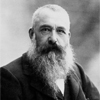
클로드 모네
Claude Monet (1840-1926) was a French painter and one of the most influential figures in the history of art. He is renowned for his role in founding the Impressionist movement, which revolutionized the way artists approached light, color, and the depiction of everyday life. Monet's innovative techniques and dedication to capturing the effects of light and atmosphere on the natural world have left an indelible mark on the art world.
Early Life and Artistic Journey: Born on November 14, 1840, in Paris, Monet displayed artistic talent from a young age. He initially pursued a traditional art education but quickly diverged from conventional methods. Instead, he sought to capture the fleeting qualities of light and color in his work, which became a defining characteristic of his style.
Impressionism and the Birth of a Movement: Monet, along with fellow artists like Édouard Manet, Pierre-Auguste Renoir, and Camille Pissarro, played a pivotal role in the development of the Impressionist movement. In 1874, Monet's painting "Impression, Sunrise" was featured in an independent exhibition, which led critics to use the term "Impressionism" to describe the movement. Impressionists aimed to capture the immediate and transient qualities of a scene, often painting en plein air (outdoors) to observe changing light and color firsthand.
Focus on Light and Atmosphere: Monet's art was characterized by his obsession with light and its various effects. He painted series of works featuring the same subject at different times of day and under different lighting conditions. His "Haystacks" and "Water Lilies" series, as well as his depictions of Rouen Cathedral and London's Houses of Parliament, showcase his exploration of changing light and atmosphere.
Techniques and Brushwork: Monet's brushwork was loose and expressive, emphasizing the sensations of light and color rather than intricate detail. He used broken and vibrant brushstrokes to create optical mixtures of color, allowing the viewer's eye to blend the hues and perceive the scene from a distance. This technique, known as "optical mixing," was a hallmark of Impressionism.
Later Years and Legacy: In his later years, Monet's focus shifted to a more immersive exploration of color and form in his iconic "Water Lilies" series. These large-scale, almost abstract works were created in his garden at Giverny, where he carefully controlled the environment to study the interplay of light and water.
Claude Monet passed away on December 5, 1926, leaving behind a legacy that transformed the course of art history. His influence can be seen in the works of subsequent generations of artists who embraced his techniques and philosophies. His dedication to observing the world around him and translating its transient beauty onto canvas created a new way of seeing and interpreting the world, forever altering the trajectory of modern art.
Contact Us: artmusee2@gmail.com

